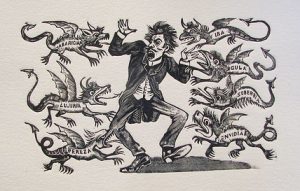Mexican painting of the first half of the 20th century
 In the 20th century, the art of Latin America, primarily Mexico, unexpectedly became one of the most significant phenomena of world culture. The dramatic history of this country is replete with brutal conquests, murders, merciless oppression of the masses – starting from the invasion of the Aztec warrior people, who later created a formidable state later in Central Mexico, in the XII century.
In the 20th century, the art of Latin America, primarily Mexico, unexpectedly became one of the most significant phenomena of world culture. The dramatic history of this country is replete with brutal conquests, murders, merciless oppression of the masses – starting from the invasion of the Aztec warrior people, who later created a formidable state later in Central Mexico, in the XII century.
In the first half of the 16th century, Spanish conquerors conquered Mexico, seized the ancient civilization that had developed here, spread Christianity with fire and sword, and turned the Indians into slaves. Indian uprisings were suppressed, as was the national struggle for the independence of Mexico. Nevertheless, in 1821, the country became an independent state, where a bitter struggle developed between the people and the reactionary forces — landowners, clergy, and military forces, who received support from outside forces: the United States troops invaded three times, the country was jointly intervened by France, England and Spain.
In 1910, the Mexican bourgeois-democratic revolution crushed the dictatorship of tyrant President Porfirio Diaz. Armed rebels, led by peasant leaders Francisco Villa and Emiliano Zapata, in 1914 occupied Mexico City. But soon the troops were driven out of the capital and scattered, the peasant and labor movement was brutally suppressed, and Villa and Zapata were treacherously killed, but the Mexican revolution contributed to the creation of a communist party in the country, carrying out important changes. Historical events have determined the content of the Mexican graphics – it is closely connected with social and political life.
When the revolution was accomplished, graphic art in Mexico was only in its infancy, and yet it had a complex and rich background. Its beginnings are connected with monumental, wall painting, and this is one of the most important features of Mexican graphics of the 20th century. Its original source is visible in the illustration of ancient Indian manuscripts and in drawings on ceramics.
The drawings – planar, with expressive silhouettes of figures and bold, rich colors – are close to the style of monumental paintings and reliefs of ancient Indian peoples. When the culture of the Aztecs and Mayans was ruthlessly destroyed, the buildings with reliefs and frescoes were almost completely destroyed, and the manuscripts with rare exceptions were burned, painting and engraving were brought to Mexico by monks from Europe. The monks saw samples of Indian art: destroying them, they themselves fell under the influence of the “demonic” art of the Indians. In any case, the paintings of the monasteries of the XVI century did not resemble the frescoes of famous Italians, even the paintings of Spanish painters. On the white walls of the Mexican monasteries in Cholula, Uekhotsingo, Aktopane there were unusual compositions made with black lines. Most of all they resembled engravings, and often were enlarged engravings. Although the paintings depicted scenes from the life of Christian saints, in them the black and white whimsical pattern resembled Indian paintings and reliefs. Both have decorativeness and love for a detailed, detailed story. The paintings were designed for Indians who could not read, they had to replace the book, and this feature was preserved in the Mexican graphic until the middle of the 20th century.
In the 19th century, secular engraving developed, first in the form of vignettes, illustrations, then simple images, and urban landscapes. Gaon’s engraver, better known under Picheta’s pseudonym, became the first Mexican caricaturist, in 1847 he founded the magazine Don Bullébullé (“Mr. Picheta’s engraving style is not original, it is closer to the European style of illustrated magazines, household and political caricatures, where the main influences of French masters – Honore Daumier, Paul Gavarni, Gustave Dore. But the very appearance of social satire in Mexico is a major event.
The beginning of the actual Mexican graphics laid the largest engraver of the XIX century – José Guadalupe Posada. He worked as an artist in newspapers, first in provincial cities, then in Mexico City. He cut household scenes, illustrations, caricatures on wood, he completed over 15 thousand engravings. Posada declared himself in the years of reaction, and at the end of his life he became the first artist of the revolution, he was admired and learned by the great masters of Mexican art. Engravings Posada responded to everything that happened in the country, they were printed in large quantities on cheap paper.
In the engravings of Posada, everything is imbued with folk spirit – the artist liked to draw pictures for folk songs and ballads, for fables and instructive parables, and especially for him “klavery” – various scenes with skeletons.




